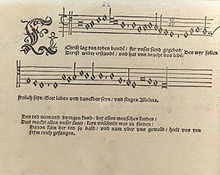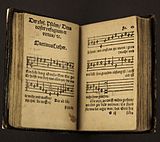- Christ lag in Todes Banden
-
For the church cantata by Bach, see Christ lag in Todes Banden, BWV 4.
 Martin Luther, author of the text of Christ lag in Todes Banden, and who, with Johann Walter, also wrote the melody
Martin Luther, author of the text of Christ lag in Todes Banden, and who, with Johann Walter, also wrote the melody
Christ lag in Todes Banden ("Christ lay in the bonds of death") is a chorale published by Martin Luther in 1533, using a traditional Eastertide melody set to words by Luther. The original Christ lag ynn todes bande is sometimes rendered as Christ lag in Todesbanden.
Contents
Text
The seven verses[1] of Luther's chorale celebrate the Resurrection of Jesus, with particular reference to a struggle between Life and Death. The third verse quotes from 1 Corinthians 15, saying that Christ's Atonement for sin has removed the "sting" of Death. The fifth verse compares the sacrifice with that celebrated by Jews in the Pascal Lamb at Passover. The tradition of baking and eating Easter Bread is referred to in the final verse. The text has been modernised in recent editions of the German Luther Hymnal.
First Verse
Christ lag in Todes Banden
Für unsre Sünd gegeben,
Er ist wieder erstanden
Und hat uns bracht das Leben;
Des wir sollen fröhlich sein,
Gott loben und ihm dankbar sein
Und singen halleluja,
Halleluja!Christ lay in death's bonds
handed over for our sins,
he is risen again
and has brought us life;
For this we should be joyful,
praise God and be thankful to him
and sing allelluia,
AlleluiaMelody
 Christ lag ynn todes bande in Johann Walter's Chorgesangbüchlein, 1524
Christ lag ynn todes bande in Johann Walter's Chorgesangbüchlein, 1524
The melody as set by Luther seems to have strong correlations with parts of the Eucharistic sequence for Easter, Victimae paschali laudes[2], believed to have been written by Wipo of Burgundy in the llth century. This was transformed, gradually into a "Leise", a devotional German pre-Reformation sung with a number of stanzas, but maintaining strong characteristics of plainsong. A new version was published by Luther in 1524 and adapted by Johann Walter in his "Wittembergisch Geistlisch Gesangbuch" (1524). This was subjected to many minor alterations in later hymnbooks, but the melodic shape remained the same in later additions, which include the addition of passing notes and modification of rhythmic patterns to conform the chorale to emerging styles, and to fit the chorale into a regular time signature.
Musical Settings
- Christ lag in Todes Banden, BWV 4, by J.S. Bach opens with a sinfonia, followed by seven movements, using each of the original seven verses by Luther, and with the melody as a cantus firmus
- Der Friede sei mit dir, BWV 158, by J.S. Bach uses the fifth verse of Martin Luther's chorale in a 4-part choral hymn in the fourth and final movement.
- Christ lag in Todes Banden, BWV 277, BWV 278 and BWV 279 are three different four part chorale settings published separately
- Christ lag in Todes Banden, BWV 625, by J.S. Bach is a chorale prelude for organ from the Orgelbüchlein, with the chorale melody in the soprano part of the right hand, accompanied by a continuous semiquaver movement in the other parts.[3] This piece lasts roughly 90 seconds[4]
- Fantasia super "Christ lag in Todes Banden", BWV 695, by J.S. Bach is a chorale prelude for organ from the Kirnberger chorale preludes (BWV 690–713). it consists of a two-part fughetta above the chorale melody in the bass [5]
- Christ lag in Todes Banden, BWV 718, by J.S. Bach is chorale prelude for organ, which uses the chorale as a cantus firmus through a range of textures, alternating between triplet and semiquaver movement.[6]
References
- ^ ""Christ lag in Todesbanden", text and translation". bach-cantatas.com. 2005. http://www.bach-cantatas.com/Texts/Chorale012-Eng3.htm. Retrieved 13 August 2010.
- ^ ""Christ ist erstanden", comparison of Easter sequence and chorale melodies". bach-cantatas.com. http://www.bach-cantatas.com/CM/Christ-ist-erstanden.htm. Retrieved 13 September 2010.
- ^ http://imslp.info/files/imglnks/usimg/b/b8/IMSLP04104-Bach_-_BGA_-_BWV_599-644.pdf%7Ctitle=Free score of BWV 625 at imslp.org|accessdate=13 September 2010|publisher=imslp.org}}
- ^ "Free Audio file at imslp.org". imslp.org. http://imslp.info/files/imglnks/usimg/b/bd/IMSLP68983-PMLP08213-c-42-11-zwo.mp3. Retrieved 13 September 2010.
- ^ http://imslp.info/files/imglnks/usimg/8/8f/IMSLP05819-Bach_-_BGA_-_BWV_690a-713a.pdf%7Ctitle=Free score of BWV 695 at imlsp.org|accessdate=13 September 2010|publisher=imslp.org}}
- ^ http://imslp.info/files/imglnks/usimg/c/ce/IMSLP05509-Bach_-_BGA_-_BWV_714-740.pdf%7Ctitle=Free score of BWV 718 at imslp.org|accessdate=13 September 2010|publisher=imslp.org}}
Categories:- Works by Martin Luther
- German hymns
Wikimedia Foundation. 2010.


